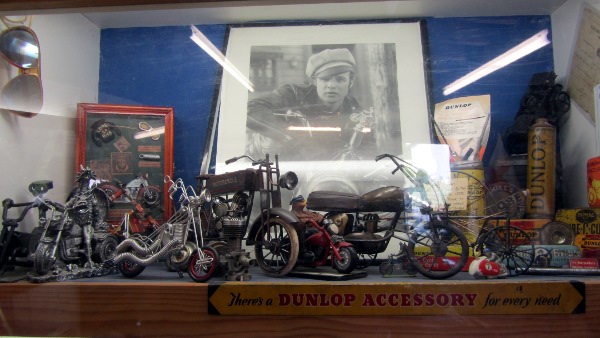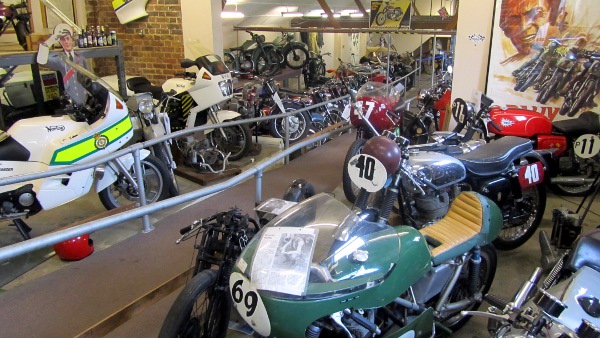Motorcycle Museum Tour – London Motorcycle Museum
Another in John Newman's great Motor Museum series
John Newman
Hands up those who have heard of the London Motorcycle Museum ?
Quite a few. Good.
Hands up those who have visited?
Just as I thought, not so many, and I have to include myself in that number. Which is shameful for a motorcycle enthusiast who has spent most of his riding and other lives around London and the South East. And it was only the task of writing about the place that got me through the door to hand over my five pound entry.
The museum is located in Greenford West London: off the A40, not too far from the Ace Cafe. The area is part of the crowded and ugly urban sprawl that rings most of our big cities, but the museum is situated in Ravenor Farm and park; an oasis of green and relative calm, away from the constant traffic flow and never ending bustle of humanity.
The museum has operated since 1999 under the drive and leadership of
Bill Crosby an extraordinary bike collector, who is also the long time owner of the Reg Allen Motorcycle Emporium in nearby Hanwell.
The old farm buildings hold a collection of some one hundred and seventy plus bikes, all British - other community organisations are based there too. In 2009, after some uncertainty about permanency at the site, Bill was able to sign a twenty five year lease with Ealing Borough Council which allowed him to to go ahead with the renovation of a lovely old barn to shelter his trusty Triumphs.
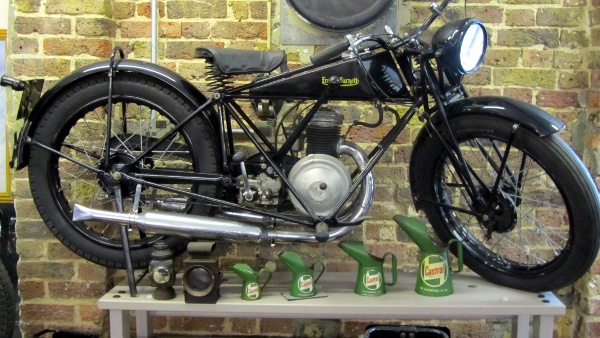
Francis Barnet
The first bike on view when you walk through from the reception area is an Indian Royal Enfield that was ridden from the Arctic to the Antarctic by Greg Staves in 1996/97 to raise money for cancer research (the bike has all the original equipment loaded plus copies of his newsletters) - Greg, a cancer sufferer, has since died, following many motorcycle fund raising journeys.
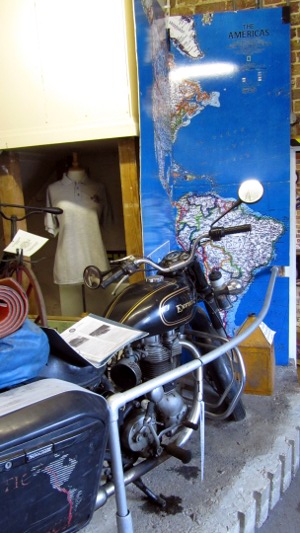
Indian Royal Enfiled which completed Arctic to Antarctic run
The main display space is crowded, and a lot of the bikes are difficult to view in any detail, and the printed information is not easily identifiable and accessible; but there are some rare examples to stimulate your interest. I'd never heard of, let alone seen, a Beardmore motorcycle before. I have now, and after looking at the history of the company on Wikipedia it's fascinating, they had eight hundred employees in the early 1900's.
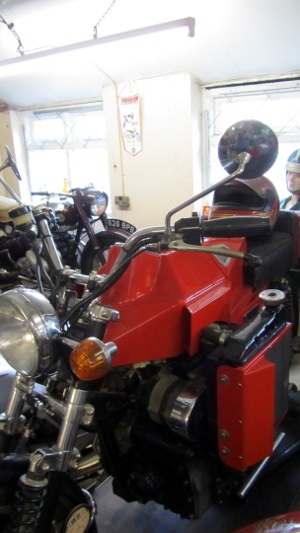
Austell 1600 with a Mini car engine. Note the radiator on one side
Further up the row a leviathan lump was raised slightly above the other displays. It turned out to be something called an Austell 1600, powered by a Mini car engine mounted sideways with the radiator prominent on one side of the bike. Just another in a long line of eccentric 'failures' that litter motorcycle manufacturing history. A bit further on, on it's own stand, stood a magnificent 1920's Coventry Eagle Flying Eight with a 996 V Twin JAP engine in the frame.
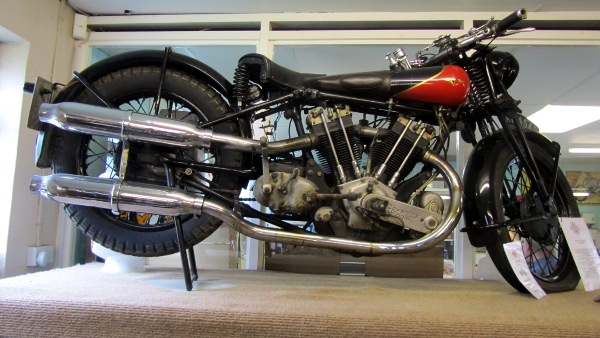
Coventry Eagle Flying Eight
Just after the Second World War a wealthy Austrian motorcycle enthusiast and engineer, Joe Ehrlich, opened a manufacturing facility down the road from the museum's location at Isleworth, where he designed and turned out EMC bikes. One of his 1947 350 two strokes is on display in the museum.
Ehrlich was an inventive and prolific designer and tuner of two stroke engines, and although the EMC factory did not survive past 1952, he went on to build top class racing units – Mike Hailwood rode one of his bikes to fifth place in the 125cc world championship in 1962.
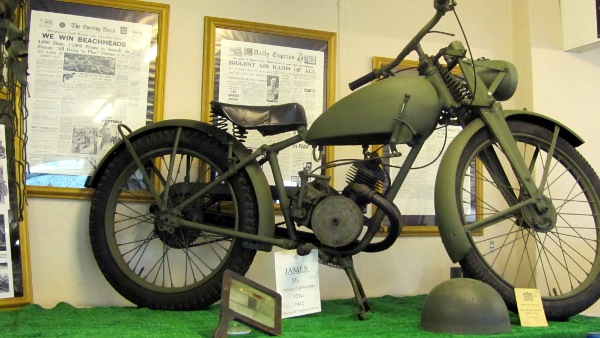
WW2 James two stroke
The epitome of cool
As I was wandering round the exhibits and chatting to Pete, one of the volunteers on hand to guide visitors and answer questions if necessary, I spotted a large framed photograph propped against the wall behind a bike: almost out of sight. It was Steve McQueen at a checkpoint when he was riding in the 1964 US International Six Day Trial (ISDT) team. Cigarette hanging loose in the mouth and covered in mud, he still looked the epitome of cool. I'd be in line with some readies if they decide to sell this to raise funds.
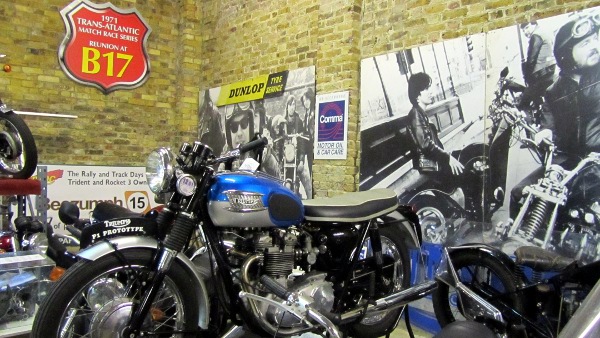
Triumph Display
After perusing the BSA collection, and their army and police bikes, I stepped through to the barn to look over the Triumphs that Bill Crosby has acquired down the years. Apparently he had them stored anywhere and everywhere he could scrounge space, so it must be good to see them now all together under the timbered roof of the 1860's restored barn.
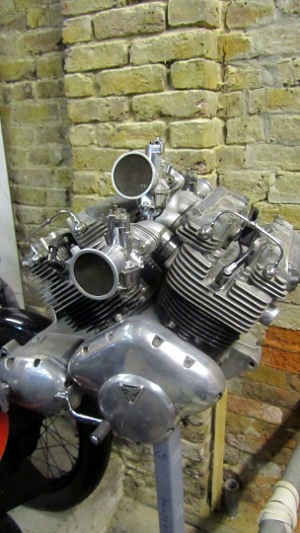
Triumph V6
Unless you're a bit of a Triumph identity geek, a lot of the models look very similar. But Bill has acquired some bikes and engines that catch the attention as you wander around. They've created a little workshop at the building's entrance with a V&M Daytona, in racing trim, standing in front.
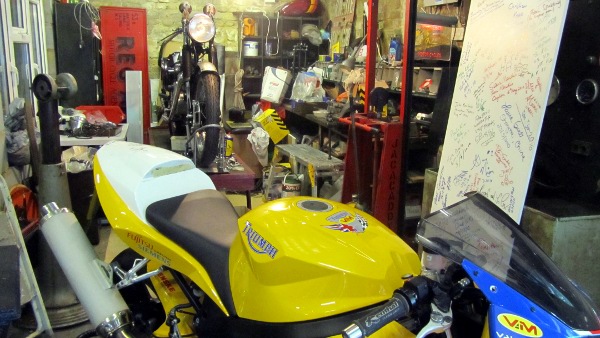
V&M Daytona - race trim
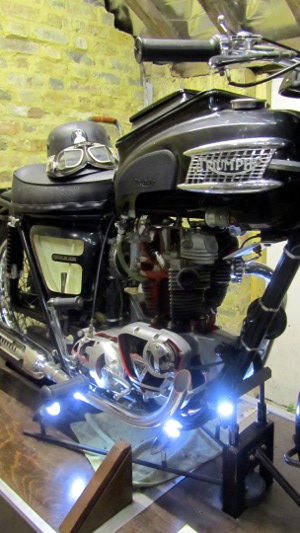
Police Bonneville
Roads circle the globe
There's a sidecar outfit that has circled the planet, and is displayed in the condition it returned from the trip, dents and all. A police Bonneville with cutaway engine and other parts sits in one corner and the engine rotates when operated. On a separate stand is a V6 engine; a special created from two Triumph triples, it's being slotted into a frame at some stage to take part in parade laps.
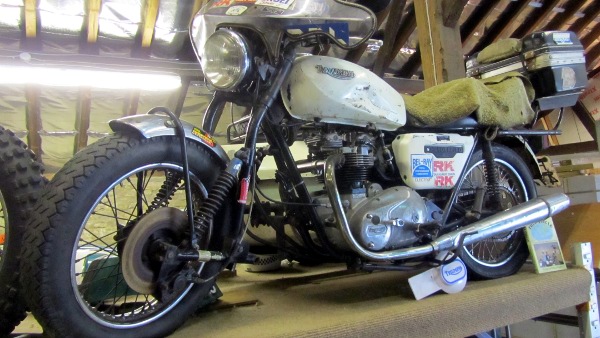
Triumph Outfit which circled the world
The museum is obviously short of space and resources. It's staffed entirely by volunteers and is only open Saturday, Sunday and Monday. They would like to expand their space and range of bikes, which can only be gradual as the number of people who will support a British only museum is dwindling. And the number and range of post Brit classics i.e. Japanese, Italian, German etc bikes is becoming ever popular.
Oil leaks dodgy electrics and all
Finding the time and expertise to source the funding required to keep a venture like this going is difficult, and motorcycling should be grateful that there are people around to keep this unique history of innovation and engineering alive: oil leaks, dodgy electrics and all.
Don't take my dilatory behaviour as an example and wait years before visiting the London Motorcycle Museum. Make a resolution to take a ride, a picnic and some money for your entrance fee (£5, concessions available) and a souvenir, and you'll help support this venture and add to your store of knowledge about all things motorcycling. I did.
Go to
www.london-motorcycle-museum.org. for further information.
They are also affiliated to the British Motorcycle Charitable Trust who promote the restoration and display of British bikes around the country's transport museums
www.bmct.org
John Newman
for
Wemoto News
